A Radiation-Pattern Reconfigurable Antenna Array for Vehicular Communications
Abstract
1. Introduction
2. Antenna Element Design
3. Pattern Reconfigurable Antenna Array
3.1. Antenna Configuration
3.2. Reconfigurable Feeding Network
3.3. Antenna Measurement and Evaluation
4. Conclusions
Author Contributions
Funding
Institutional Review Board Statement
Informed Consent Statement
Data Availability Statement
Conflicts of Interest
References
- Kowalewski, J.; Eisenbeis, J.; Tingulstad, M. Design method for capacity enhancement of pattern-reconfigurable MIMO vehicular antennas. IEEE Antennas Wirel. Propag. Lett. 2019, 18, 2557–2561. [Google Scholar] [CrossRef]
- Chletsou, A.; Locke, J.F.; Papapolymerou, J. Vehicle platform effects on performance of flexible, lightweight, and dual-band antenna for vehicular communications. IEEE J. Microw. 2021, 2, 123–133. [Google Scholar] [CrossRef]
- Wang, J.; Zhao, X.; Ye, Y.; Liu, S. A millimeter-wave ultrawideband tightly coupled dipole array antenna for vehicle communication. IEEE Antennas Wirel. Propag. Lett. 2022, 21, 2135–2139. [Google Scholar] [CrossRef]
- Mallick, P.; Ameen, M.; Chowdhury, R.; Ray, A.K.; Chaudhary, R.K. Wideband circularly polarized cavity-backed dielectric resonator antenna with low RCS for aerial vehicle communications. IEEE Antennas Wirel. Propag. Lett. 2022, 21, 1418–1422. [Google Scholar] [CrossRef]
- Moltchanov, D.; Beschastnyi, V.A.; Ostrikova, D.; Gaidamaka, Y.; Koucheryavy, Y.; Samouylov, K.E. Optimal antenna locations for coverage extension in sub-terahertz vehicle-to-vehicle communications. IEEE Trans. Wirel. Commun. 2023, 22, 5990–6002. [Google Scholar] [CrossRef]
- Chen, S.L.; Qin, P.Y.; Lin, W. Pattern-reconfigurable antenna with five switchable beams in elevation plane. IEEE Antennas Wirel. Propag. Lett. 2018, 17, 454–457. [Google Scholar] [CrossRef]
- Ashvanth, B.; Partibane, B.; Alsath, M.G.N.; Kalidoss, R. Gain enhanced multipattern reconfigurable antenna for vehicular communications. Int. J. RF Microw. Comput. Aided Eng. 2020, 30, 22192. [Google Scholar] [CrossRef]
- Haydhah, S.A.; Ferrero, F.; Lizzi, L.; Sharawi, M.S.; Zerguine, A. A multifunctional compact pattern reconfigurable antenna with four radiation patterns for sub-GHz IoT applications. IEEE Open J. Antennas Propag. 2021, 2, 613–622. [Google Scholar] [CrossRef]
- Gaya, S.; Hamza, A.; Sokunbi, O.; Sheikh, S.I.; Attia, H. Electronically Switchable Frequency and Pattern Reconfigurable Segmented Patch Antenna for Internet of Vehicles. IEEE Internet Things J. 2024, 11, 17840–17851. [Google Scholar] [CrossRef]
- Rongas, D.; Paraskevopoulos, A.; Marantis, L.; Kanatas, A.G. An integrated shark-fin reconfigurable antenna for V2X communications. Prog. Electromagn. Res. C 2020, 100, 1–16. [Google Scholar] [CrossRef]
- Lin, W.; Wong, H.; Ziolkowski, R.W. Wideband pattern-reconfigurable antenna with switchable broadside and conical beams. IEEE Antennas Wirel. Propag. Lett. 2017, 16, 2638–2641. [Google Scholar] [CrossRef]
- Ma, C.J.; Xiang, B.J.; Zheng, S.Y. A miniaturized planar multibeam antenna for millimeter-wave vehicular communication. IEEE Trans. Veh. Technol. 2022, 72, 3611–3621. [Google Scholar] [CrossRef]
- You, Y.; Ford, K.L.; Rigelsford, J.M. Systems analysis of a pattern reconfigurable antenna for capacity improvement of cell edge users in cellular networks. IEEE Trans. Veh. Technol. 2018, 67, 11848–11857. [Google Scholar] [CrossRef]
- Wang, Z.; Ning, Y.; Dong, Y. Compact shared aperture quasi-Yagi antenna with pattern diversity for 5G-NR applications. IEEE Trans. Antennas Propag. 2020, 69, 4178–4183. [Google Scholar] [CrossRef]
- Wang, Z.; Liu, S.; Dong, Y. Compact wideband pattern reconfigurable antennas inspired by end-fire structure for 5G vehicular communication. IEEE Trans. Veh. Technol. 2022, 71, 4655–4664. [Google Scholar] [CrossRef]
- Boukarkar, A.; Rachdi, S.; Amine, M.M. A compact four states radiation-pattern reconfigurable monopole antenna for Sub-6 GHz IoT applications. AEU-Int. J. Electron. Commun. 2023, 158, 154467. [Google Scholar] [CrossRef]
- Hossain, M.A.; Bahceci, I.; Cetiner, B.A. Parasitic layer-based radiation pattern reconfigurable antenna for 5G communications. IEEE Trans. Antennas Propag. 2017, 65, 6444–6452. [Google Scholar] [CrossRef]
- Zhang, L.; Gao, S.; Luo, Q. Planar ultrathin small beam-switching antenna. IEEE Trans. Antennas Propag. 2016, 64, 5054–5063. [Google Scholar] [CrossRef]
- Palsokar, A.A.; Lahudkar, S.L. Frequency and pattern reconfigurable rectangular patch antenna using single PIN diode. AEU-Int. J. Electron. Commun. 2020, 125, 153370. [Google Scholar] [CrossRef]
- Zhao, S.; Wang, Z.; Dong, Y. A planar pattern-reconfigurable antenna with stable radiation performance. IEEE Antennas Wirel. Propag. Lett. 2022, 21, 784–788. [Google Scholar] [CrossRef]
- Jin, G.; Li, M.; Liu, D. A simple planar pattern-reconfigurable antenna based on arc dipoles. IEEE Antennas Wirel. Propag. Lett. 2018, 17, 1664–1668. [Google Scholar] [CrossRef]
- Sun, H.; Hu, Y.; Ren, R. Design of pattern-reconfigurable wearable antennas for body-centric communications. IEEE Antennas Wirel. Propag. Lett. 2020, 19, 1385–1389. [Google Scholar] [CrossRef]
- Jin, G.; Li, M.; Liu, D.; Zeng, G. A simple four-beam reconfigurable antenna based on monopole. IEEE Access 2018, 6, 30309–30316. [Google Scholar] [CrossRef]
- Row, J.S.; Huang, Y.J. Reconfigurable antenna with switchable broadside and conical beams and switchable linear polarized patterns. IEEE Trans. Antennas Propag. 2018, 66, 3752–3756. [Google Scholar] [CrossRef]
- Li, R.; Yang, H.; Liu, B. Theory and realization of a pattern-reconfigurable antenna based on two dipoles. IEEE Antennas Wirel. Propag. Lett. 2018, 17, 1291–1295. [Google Scholar] [CrossRef]
- Cheng, Y.F.; Ding, X.; Shao, W. Planar wide-angle scanning phased array with pattern-reconfigurable windmill-shaped loop elements. IEEE Trans. Antennas Propag. 2016, 65, 932–936. [Google Scholar] [CrossRef]
- Wen, Y.; Yang, D.; Zeng, H. Bandwidth enhancement of low-profile microstrip antenna for MIMO applications. IEEE Trans. Antennas Propag. 2017, 66, 1064–1075. [Google Scholar] [CrossRef]
- Zhang, H.Y.; Zhang, F.S.; Zhang, F. Bandwidth enhancement of a horizontally polarized omnidirectional antenna by adding parasitic strips. IEEE Antennas Wirel. Propag. Lett. 2016, 16, 880–883. [Google Scholar] [CrossRef]
- Le, T.N.; Pegatoquet, A.; Le Huy, T.; Lizzi, L.; Ferrero, F. Improving energy efficiency of mobile WSN using reconfigurable directional antennas. IEEE Commun. Lett. 2016, 20, 1243–1246. [Google Scholar] [CrossRef]
- Kittiyanpunya, C.; Krairiksh, M. A four-beam pattern reconfigurable Yagi-Uda antenna. IEEE Trans. Antennas Propag. 2013, 61, 6210–6214. [Google Scholar] [CrossRef]
- Ding, X.; Wang, B. A novel wideband antenna with reconfigurable broadside and endfire patterns. IEEE Antennas Wirel. Propag. Lett. 2013, 12, 995–998. [Google Scholar]
- Wu, Z.; Tang, M.; Li, M.; Ziolkowski, R.W. Ultralow-profile, electrically small, pattern-reconfigurable metamaterial-inspired huygens dipole antenna. IEEE Trans. Antennas Propag. 2020, 68, 1238–1248. [Google Scholar] [CrossRef]
- Cao, Y.F.; Zhang, X.Y. A wideband beam-steerable slot antenna using artificial magnetic conductors with simple structure. IEEE Trans. Antennas Propag. 2018, 66, 1685–1694. [Google Scholar] [CrossRef]
- Yang, Y.; Zhao, Z.; Ding, X.; Nie, Z.; Liu, Q.H. Single slot antenna with multiple radiation modes using a parasitic loop pair. IEEE Trans. Antennas Propag. 2019, 67, 1335–1340. [Google Scholar]
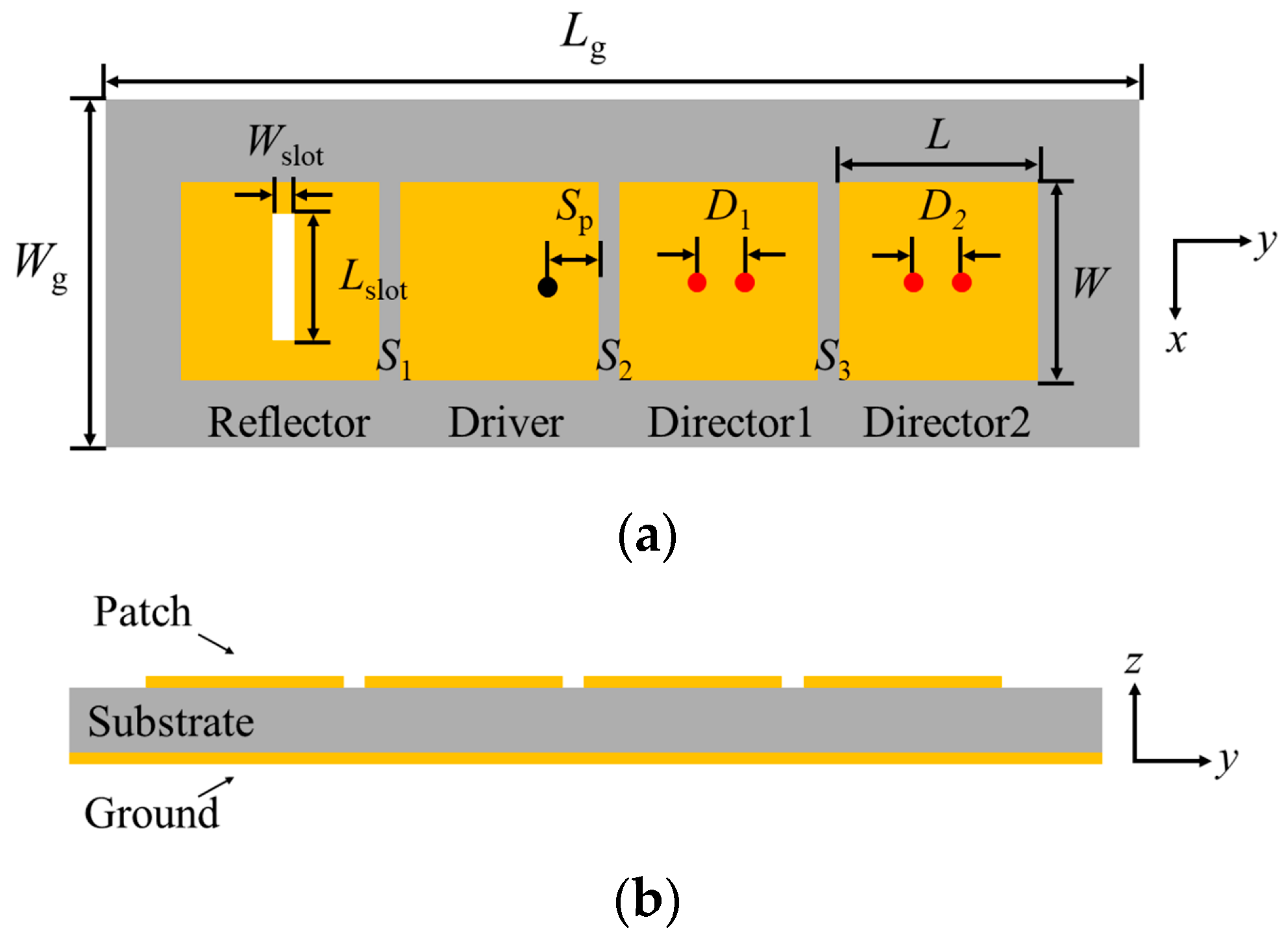


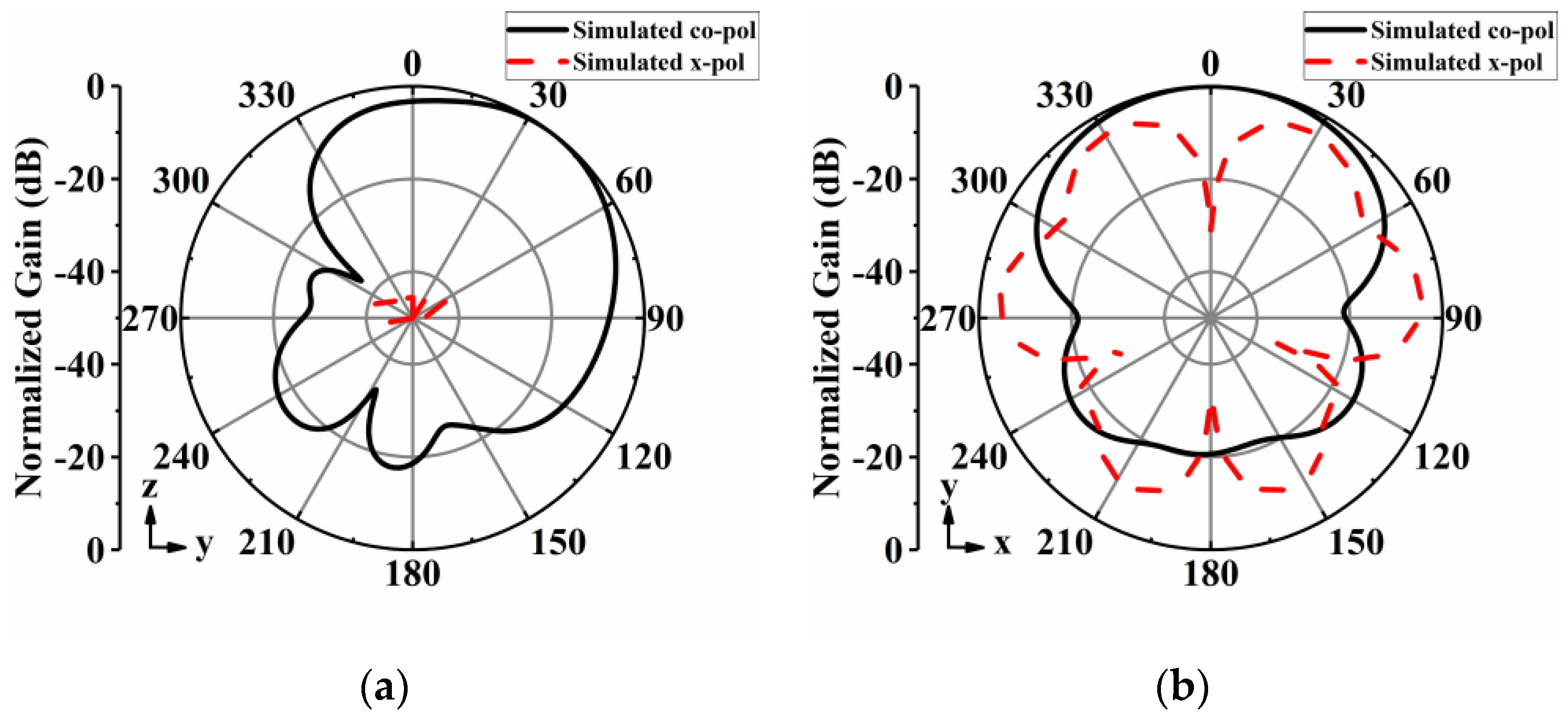
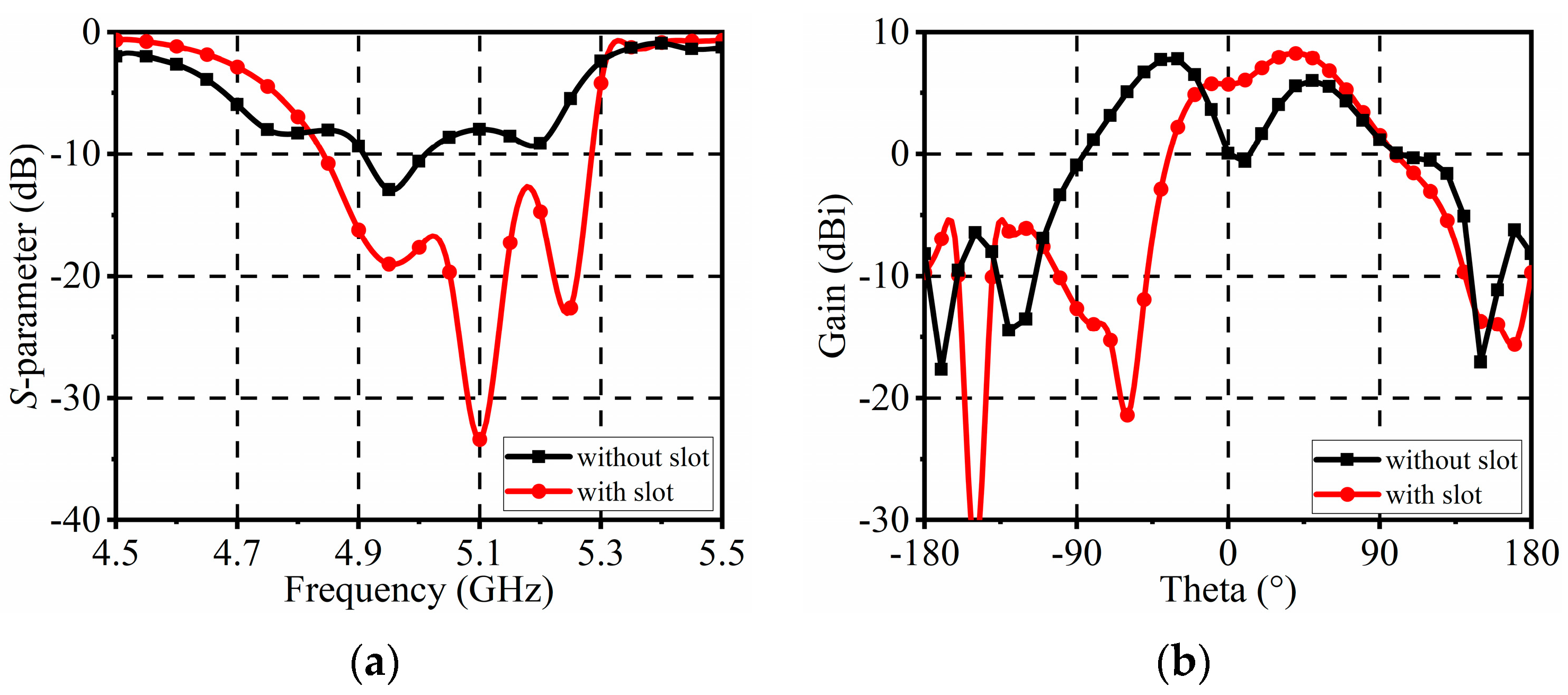






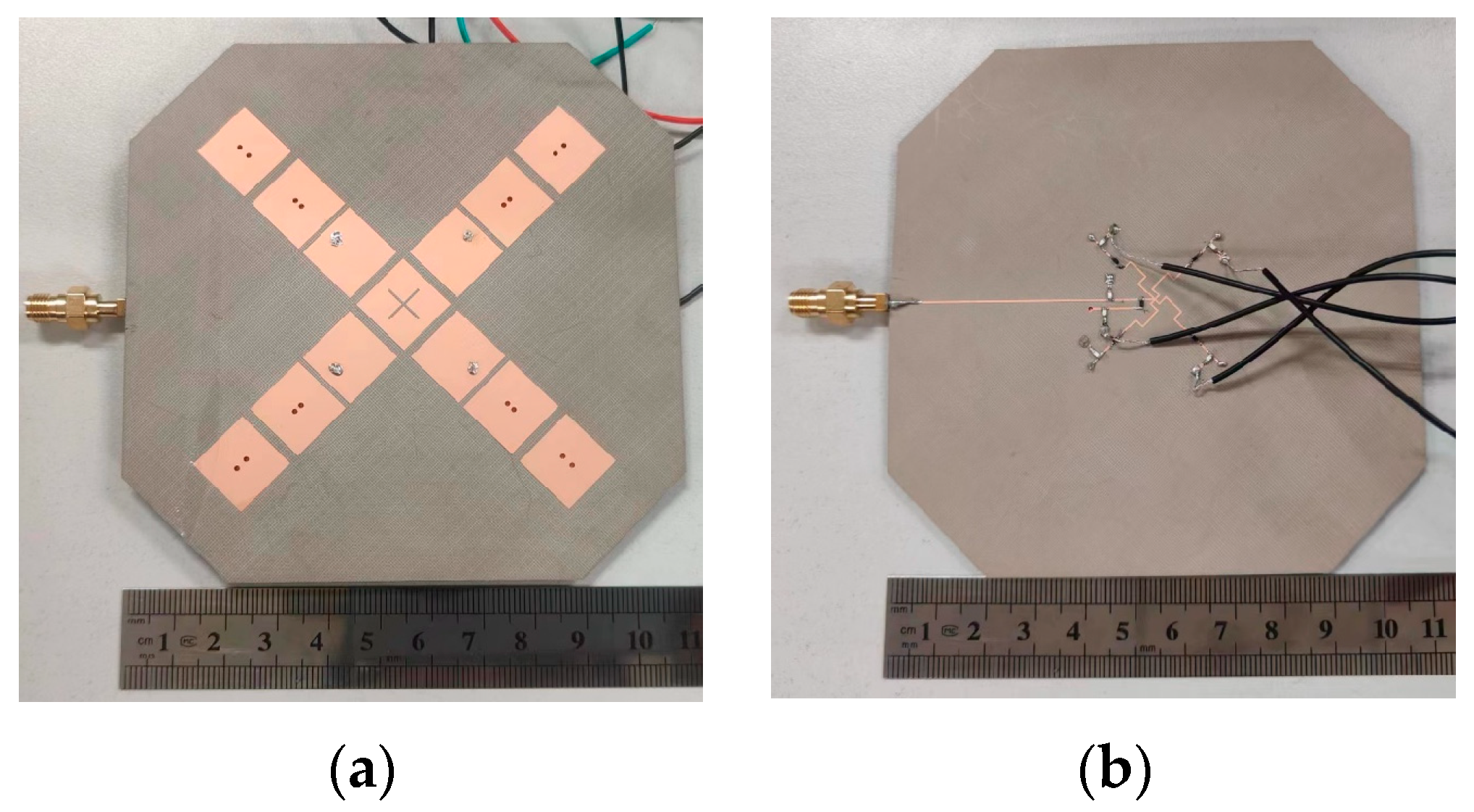




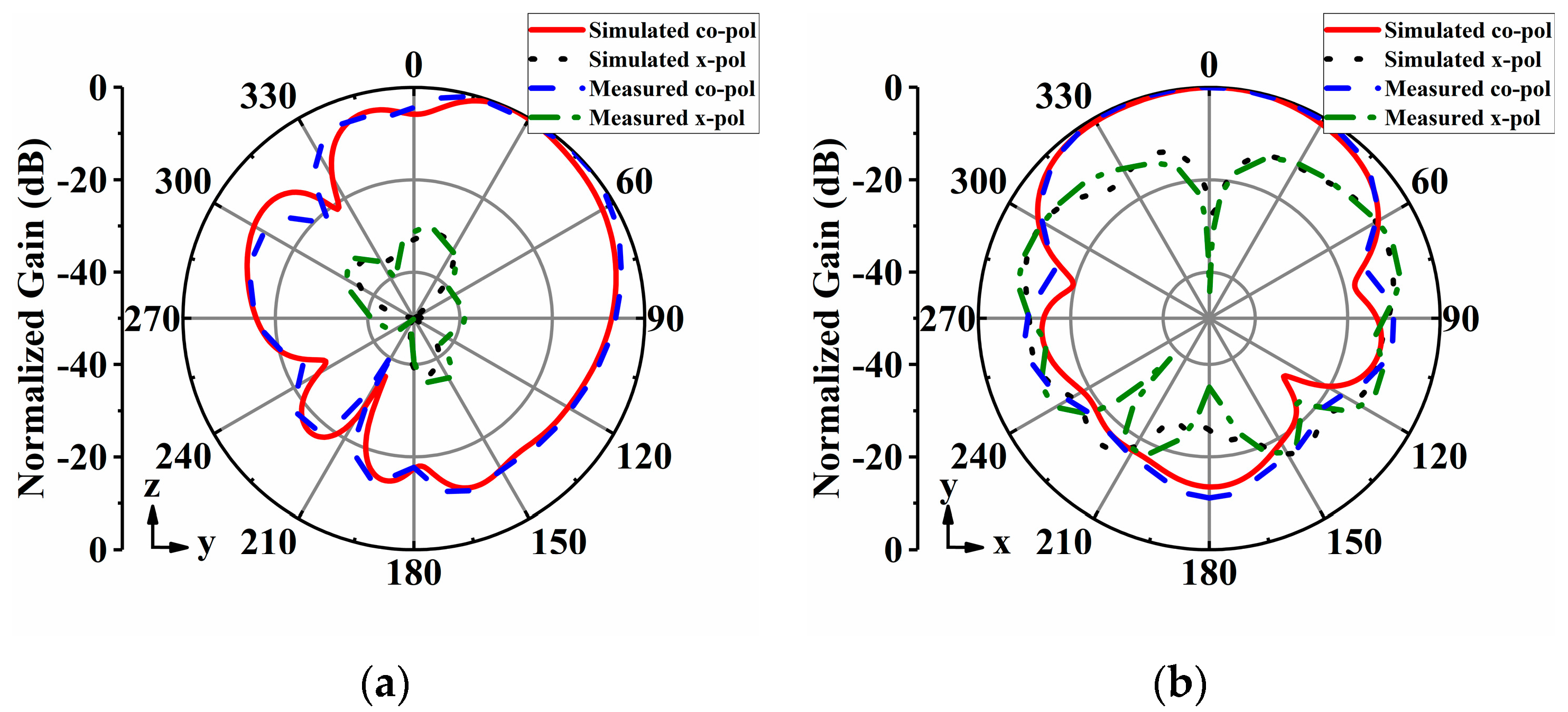

| Parameters | Value (mm) | Parameter | Value (mm) |
|---|---|---|---|
| L | 13.4 | S3 | 2 |
| W | 13.4 | Sp | 3.3 |
| Lslot | 8.5 | D1 | 1.7 |
| Wslot | 0.5 | D2 | 2.5 |
| S1 | 1.8 | Lg | 100 |
| S2 | 1.1 | Wg | 60 |
| Mode | S1 | S2 | S3 | S4 | S5 | Radiation |
|---|---|---|---|---|---|---|
| 1:1 (State I) | on | off | off | off | off | Directional |
| 1:1 (State II) | off | on | off | off | off | Directional |
| 1:1 (State III) | off | off | on | off | off | Directional |
| 1:1 (State IV) | off | off | off | on | off | Directional |
| 1:4 (State V) | on | on | on | on | on | Omnidirectional |
| Ref. | Size (λ03) | Reconfigurability | No. of Diodes | Bandwidth (%) | Peak Gain (dBi) | Efficiency (%) |
|---|---|---|---|---|---|---|
| [31] | 1.1 × 0.5 × 0.06 | 3-state beams | 4 | 29 | 6.2 | 68 |
| [32] | 0.259 × 0.16 × 0.08 | 3-state beams | 2 | 1.3 | 5.4 | 85 |
| [21] | 0.613 × 0.612 × 0.1 | 4-state beams | 4 | 33.6 | 4.11 | 60 |
| [33] | 1.16 × 1.16 × 0.26 | 3-state beams | 2 | 11.5 | 9.3 | N.A. |
| [34] | 0.57 × 0.57 × 0.04 | 4-state beams | 2 | 8.2 | 2 | N.A. |
| This work | 2.4 × 2.4 × 0.03 | 5-state beams | 5 | 11 | 9.3 | 88 |
Disclaimer/Publisher’s Note: The statements, opinions and data contained in all publications are solely those of the individual author(s) and contributor(s) and not of MDPI and/or the editor(s). MDPI and/or the editor(s) disclaim responsibility for any injury to people or property resulting from any ideas, methods, instructions or products referred to in the content. |
© 2024 by the authors. Licensee MDPI, Basel, Switzerland. This article is an open access article distributed under the terms and conditions of the Creative Commons Attribution (CC BY) license (https://creativecommons.org/licenses/by/4.0/).
Share and Cite
Gao, F.; Sun, H. A Radiation-Pattern Reconfigurable Antenna Array for Vehicular Communications. Sensors 2024, 24, 4136. https://doi.org/10.3390/s24134136
Gao F, Sun H. A Radiation-Pattern Reconfigurable Antenna Array for Vehicular Communications. Sensors. 2024; 24(13):4136. https://doi.org/10.3390/s24134136
Chicago/Turabian StyleGao, Feng, and Hucheng Sun. 2024. "A Radiation-Pattern Reconfigurable Antenna Array for Vehicular Communications" Sensors 24, no. 13: 4136. https://doi.org/10.3390/s24134136
APA StyleGao, F., & Sun, H. (2024). A Radiation-Pattern Reconfigurable Antenna Array for Vehicular Communications. Sensors, 24(13), 4136. https://doi.org/10.3390/s24134136







